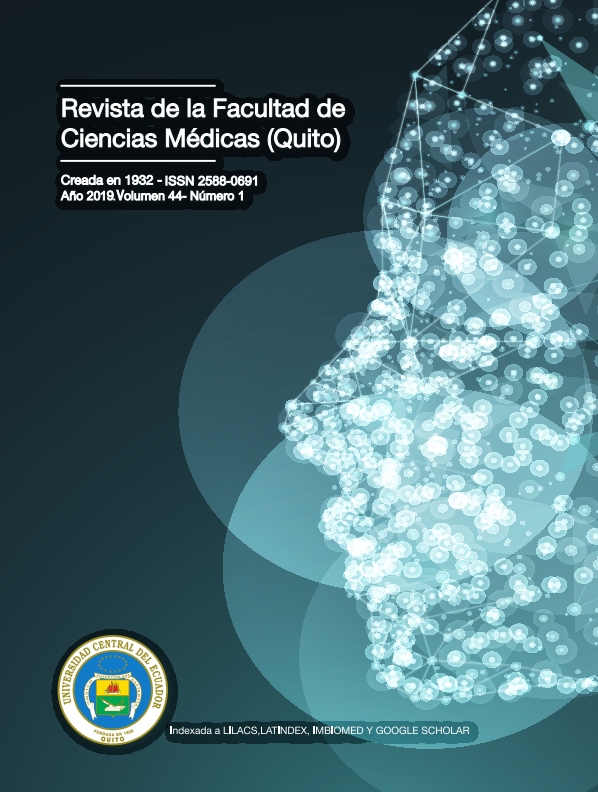Evaluation of the functional properties of the quinoa protein isolate (Chenopodium quinoa Willd) INIAP-TUNKAHUAN variety with potential use in human nutrition
DOI:
https://doi.org/10.29166/ciencias_medicas.v44i1.1969Keywords:
Chenopodium Quinoa Willd, protein isolate, functional properties, phenolic compoundsAbstract
Background: Quinoa is a gluten-free food has high potential in human nutrition, due to its high nutritional value, high protein quality, whose functional properties are ideal for development of new food products with high added value; however, these properties can be lost during processing
Objective: To evaluate the effect of two protein extraction procedures (with and without the removal of phenolic compounds) on the functional properties of protein isolates obtained from the quinoa flour INIAP Tunkahuan variety.
Methods: Isolation of quinoa proteins was performed by solubilization at alkaline pH (9.0) / isoelectric precipitation at acidic pH (5.0). The removal of phenolic compounds was carried out with an acid treatment (pH 4.5) prior to the extraction of their proteins. The technological potential in the lyophilized isolate was evaluated through functional properties.
Results: The removal of compounds significantly affected the color of the protein isolate, making it darker, also caused a decrease in the amount of protein extracted, in its water retention capacity and in its emulsifying property, while the foaming capacity was independent of procedure used. Finally, a higher viscosity was observed in the protein isolate obtained without removal of phenolic compounds.
Conclusion: Quinoa proteins can be a promising ingredient in the production of functional foods, but studies need to continue on the bioactive properties of their peptides.
Downloads
Metrics
References
Repo-Carrasco-Valencia R, Hellström JK, Pihlava J-M, Mattila PH. Flavonoids and other phenolic compounds in Andean indigenous grains: Quinoa (Chenopodium quinoa), kañiwa (Chenopodium pallidicaule) and kiwicha (Amaranthus caudatus) Food Chem. 2010;10:128-133.
Lutz M, Martínez A, Martínez EA. Daidzein and Genistein contents in seeds of quinoa (Chenopodiumquinoa Willd.) from local ecotypes grown in arid Chile. Industrial Crops and Products. 2013;49:117-121.
Graf BL, Poulev A, Kuhn P, Grace MH, Lila MA, Raskin I. Quinoa seeds leach phytoecdysteroids and other compounds. Food Chem. 2014;163:178-85
Elsohaimy SA, Refaay TM, Zaytoun MA. Physicochemical and functional properties of quinoa protein isolate. Annals of Agricultural Science. 2015;60(2):297-305
Ando H, Chen YC, Tang H, Shimizu M, Watanabe K, Mitsunaga T. Food Components in Fractions of Quinoa Seed. Food Sci Technol Res. 2002;8(1):80-84
Przygoda K, Wejnerowska G. Extraction of tocopherol-enriched oils from Quinoa seeds by supercritical fluid extraction. Ind Crop Prod. 2015;63:41-47.
Aluko RE, Monu E. Functional and bioactive poperties of quinoa seed protein hyrolysates. Food Chem Toxicol. 2003;68(4):1254-1258
Reyes Montaño E, Ávila Torres D, Guevara Pulido JO. Componente nutricional de diferentes variedades de quinua de la Región Andina. Avances. 2006;5:86-97
Villacrés E, Cuadrado L, Falconí F. 2013. Los granos andinos: chocho (Lupinus mutabilis Sweet.) quinua (Chenopodium quinoa Willd) amaranto (Amaranthus caudatus L.) y sangoroche (Amaranthus hybridus L.) fuente de metabolitos secundarios y fibra dietética. Boletín técnico Nº 165. Departamento de Nutrición y Calidad, INIAP-Facultad de Ciencias de la Salud, UNACH. ISBN: 9942-07-56
Tapia IL, Taco DR, Taco TV. Aislamiento de proteínas de quínua ecuatoriana (Chenopodium quinoa Wild) variedad INIAP Tunkahuán con remoción de compuestos fenólicos, para uso potencial en la nutricióny salud humana. Rev Fac de Cien Med. (Quito). 2016;41(1): 71-80
Ma M, Ren Y, Xie W, Zhou D, Shurong T, Kuang M, et al. Physicochemical and functional properties of protein isolate obtained from cottonseed meal. Food Chem. 2018;240: 856-62
Rubino MI, Amfield SD, Nadon CA, Bernatsky A. Phenolic protein interactions in relation to the gelation properties of canola protein. Food Res Int. 1996;29(7):653-59
Bejosano BP, Corke H. Protein quality evaluation of amaranthus wholemeal flours and protein concentrates. J Sci Food Agri. 1998;76:100-106.
González-Pérez , Merck KB, Vereijken M, Van Koningsveld A, Gruppen H, Voragen AG. Isolation and characterization of undenatured chlorogenic acid free sunflower (Helianthus annuus) proteins. J Agric Food Chem. 2002;50(61):1713-19.
Kirk R, Sawyer R, H. E. Composición y anáisis de los alimentos. México: Compañía Editorial Continental; 1999
Latimer G. Official methods of analysis of AOAC International. Décima novena ed. Maryland: AOAC International; 2012
Miller J, Miller J. Estadística y Quimiometría para la Química Analítica Madrid: Prentice Hall; 2002
Sathe SK, Salunkhe DK. Functional properties of the great northern bean (Phaseolus vulgaris L.) proteins: Emulsion, foaming, viscosity, and gelation properties. J Food Sci. 1981;46(1):71-81
Robertson JA. Hydration properties of dietary fiber and resistant starch: a European Collaboraty Study. IWT. 2000;33(2):73-79
Chau CF, Cheung PC, Wong YS. Functional properties of protein concentrates from three Chinese indigenous legume seeds. J Agric Food Chem. 1997;7(45):2500-2503
Badui. S. Química de los Alimentos. México: PEARSON Eduación; 2006
Polat H. Kinetics of oil dispertion in the absence and presence of block copolymers. AlCHE J. 1999;45(9):1866-74
Vega-Gálvez A, Miranda M, Vergara J, Uribe E, Puente L, Martínez E. Nutrition facts and functional potential of quinoa (Chenopodium quinoa Willd.) an ancient Andean grain: a review. J Sci Food Agric. 2010;90(15):2541-47











